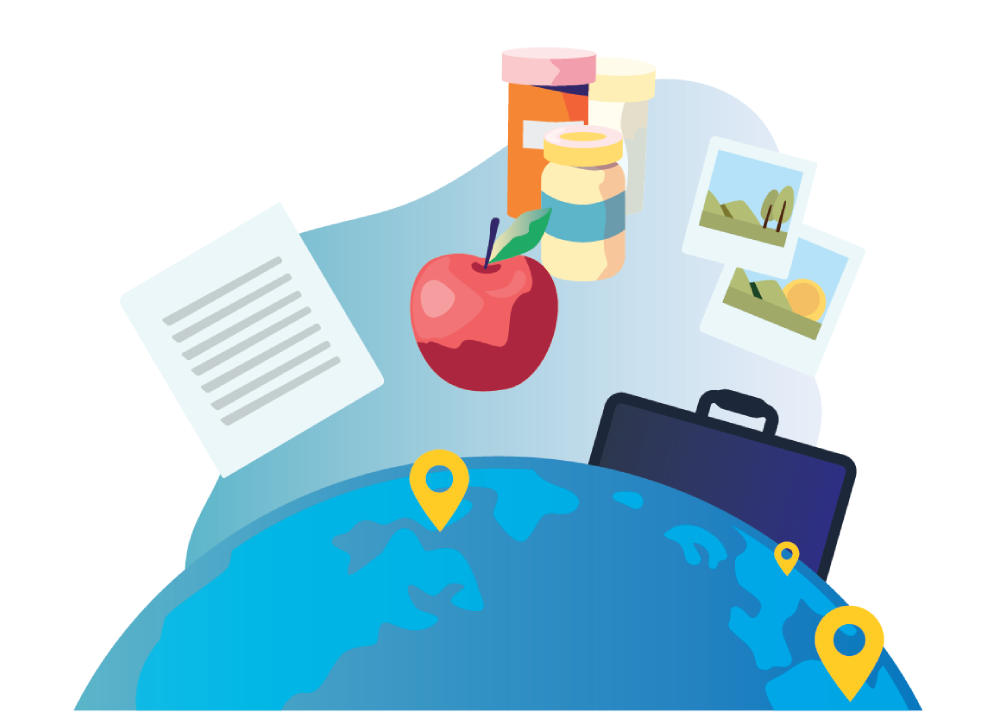Managing Diabetes Highlights:
- Packing insulin and other diabetes supplies for car and air travel
- Managing blood glucose levels with time zone changes
- What to expect at border crossings and once you arrive
- Planning ahead can help you to enjoy a carefree trip
Many Canadians are itching to travel. If you have type 1 or type 2 diabetes, you should take some precautions before and during your trip. Careful planning can help you to maintain your blood glucose targets during travel and avoid disruptions.
Consider your diabetes needs before you leave
- It is a good idea to get a letter from your family doctor or a health care professional familiar with you, stating that you need the supplies and medication you will be carrying. Sometimes needles and syringes present a problem at airport security, so this letter can be useful.
- Ask your local pharmacy to print a detailed list of your medications. Ensure that all medications and devices (test strips, lancets, and pen needles) are labeled with a prescription label. The name on the label should match the name on your passport.
- Research the area where you will be travelling, and know the location of the nearest hospital. Learn a few simple but important sentences in the local language, such as, “I have diabetes.” Medical awareness jewelry can be very useful as well.
- Make sure you have travel insurance and are familiar with what it covers. Some policies do not insure existing conditions, and only cover new conditions that arise when travelling. You may have to shop around to find a policy that suits you.
- If a recommended change to your medication or dosage could affect your travel insurance, discuss it with your doctor. Often the adjustment can wait until you return.
- Pack basic first-aid items like bandages and over-the-counter antibiotic ointment.
- Have your vaccine history assessed by a health care professional such as your pharmacist or doctor. It is important to receive any necessary vaccines well in advance of your trip to ensure you have time to receive all doses and to obtain maximal effectiveness.
- Choose comfortable footwear that you know fits well. Wear new shoes around your home to break them in before you leave. You want to prevent minor foot injuries, such as blisters caused by wearing new sandals. To avoid risk of injury from glass, seashells or other debris, people with diabetes should avoid walking barefoot, for example at the beach.
Tips for packing insulin
If you use insulin, you will need to do some advance planning.
- Keep your insulin with you in your carry-on rather than packing it in your checked luggage. Not only do you risk going without it if your luggage is lost, but the temperature of checked luggage can vary greatly.
- As long as you declare your items at security, it should not matter if they exceed 100 millilitres. You may be subject to additional screening, so arrive at the airport with time to spare.
- Once you arrive at your destination, most insulin is stable at room temperature for four weeks. Depending on where you are travelling and what your accommodations are, you may need to pack a hard-sided cooler and cold packs.
- Bring extra supplies, such as alcohol swabs or hand sanitizer in case you are unable to wash your hands.
- Be sure to pack glucose tablets, extra water, and extra snacks so you are prepared if you experience hypoglycemia (low blood glucose). Become familiar with how to treat low blood glucose, and know the symptoms (such as lightheadedness, excessive sweating, increased heart rate, dizziness, and irritability).
Flying with diabetes supplies
- If you use an insulin pump, request that airport security staff screen you with a wand rather than having you go through an X-ray machine. X-rays can damage the internal programming of an insulin pump. Ask before the screening begins, as you may be denied if you make the request during the process.
- Airport screeners may visually inspect you with your pump in place since it cannot be removed. If airport security inspects your medications and medical supplies, repack them yourself once the screening process is complete. These items are at risk of damage or contamination if not re-packed properly.
- Jet engines can be very loud. It can be hard to hear the sound alarm on devices such as an insulin pump, a flash glucose monitor (isCGM) like FreeStyleLibre 2, or a continuous glucose monitor (rtCGM) like Dexcom. To avoid missing an alert, put the device on vibrate and keep it close to you.


Top tips for travelling with diabetes
- Pack extra supplies, glucose tablets and snacks.
- Carry a list of your medications, and label your diabetes supplies.
- Buy the appropriate travel insurance.
- Be sure that those travelling with you are aware of your medical condition.
Diabetes and other forms of travel
- Precautions for travelling by car or by sea are much the same as for travelling by air, with the exception of being screened by security. You will still want to test your blood glucose regularly (every four hours). Pack lots of extra testing supplies.
- Be sure to pack many snacks, and always have glucose tablets on hand in case of a blood glucose low.
- If you are travelling by sea, specifically on a cruise, add regular exercise like walking to your schedule to account for the extra calories you may consume.
Arriving at your destination
- Travelling into a different time zone requires planning. Either you will lose time (generally, this means travelling east), or you will gain time (this usually means travelling west). If you are going to lose more than two hours, your day will be shorter. This means you may need to take less of your intermediate or long-acting insulin. If you are going to gain more than two hours, your day may be longer. You may require more short-acting insulin as well as more food. Speak to your diabetes health professional before you go to develop a plan that is specific to you.
- If you will be hiking during your trip, it is best to avoid going alone. Carry a first aid kit that includes glucose tablets and a glucagon emergency kit if you use insulin. Make sure someone with you knows how to use the kit. It is strongly recommended that you tell someone who will not be on the hike where you are going and when you plan to return.
Thinking about how to care for your diabetes while you are away from home can feel overwhelming. Careful planning helps to ensure that your next trip is worry-free. By taking precautions, you can have a very enjoyable trip.
This 2022 Managing Diabetes article was written by Zoe MacInnis, B. Sc. Pharm, Pharmacy Manager of the Lawtons Pharmacist Walk-In Clinic+ in New Glasgow, Nova Scotia.



